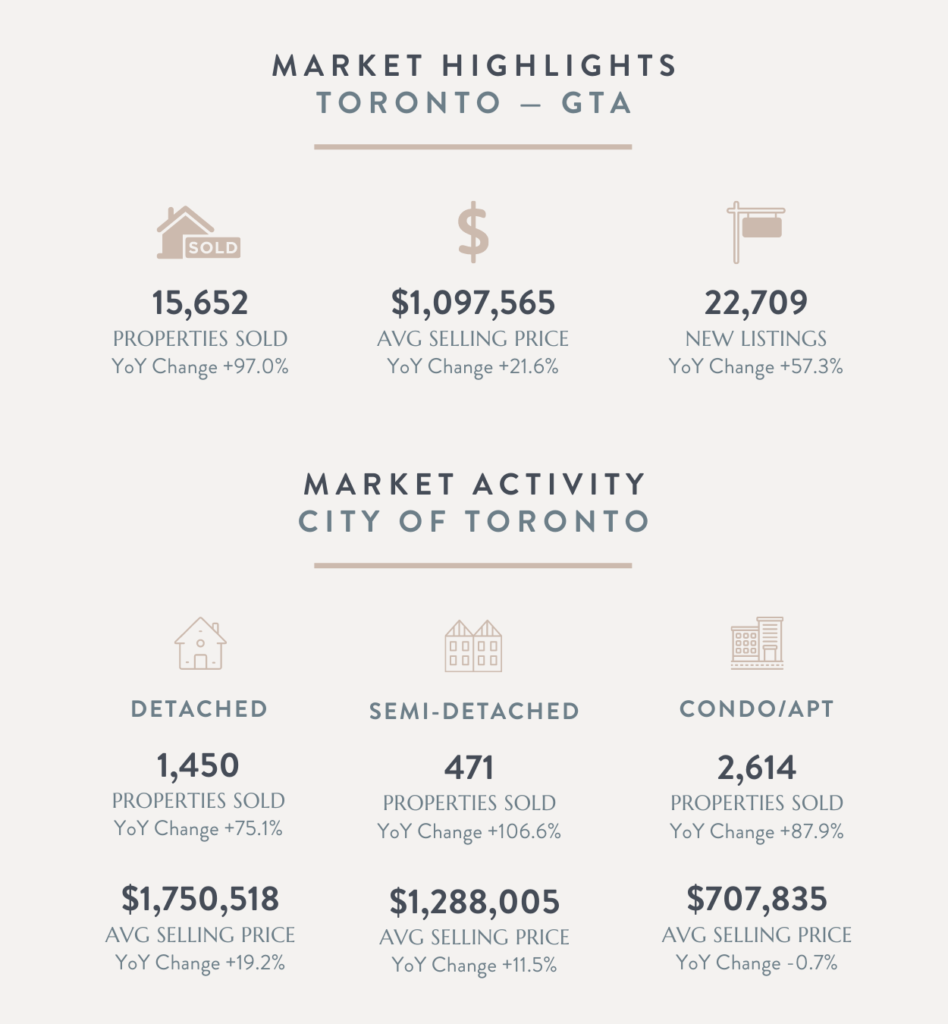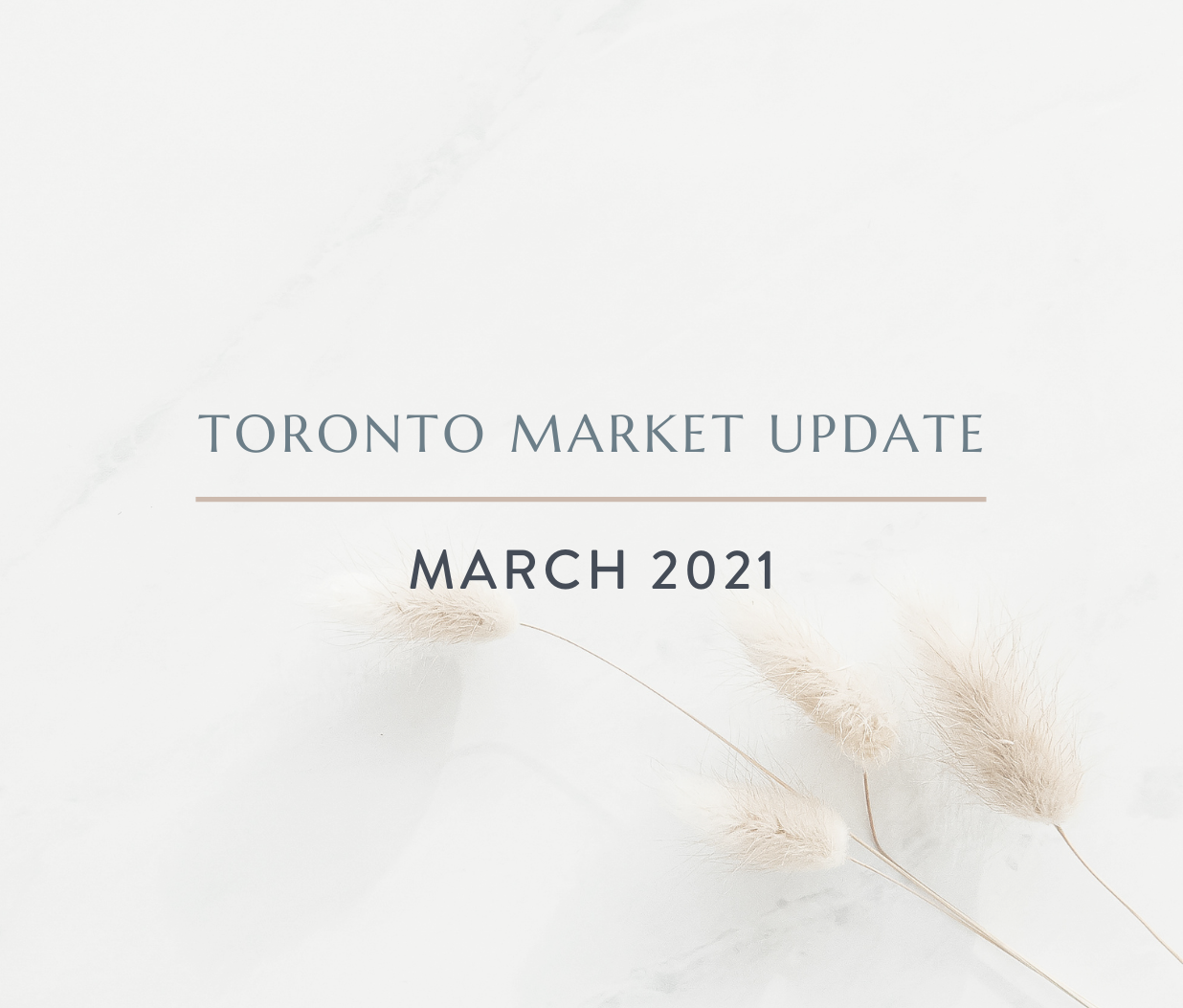This content was originally published in The Toronto Real Estate Market Report With Chris Kapches on Chestnut Park Real Estate Brokerage’s Blog.
Just when you think the Toronto residential resale market can’t reach new heights, it surprises us again. March was not only strong but it shattered records, something that is becoming a common occurrence.
In March 15,652 homes were reported sold, an all-time monthly record and 97 percent more than the 7,945 properties sold last March. Even considering that the second half of March 2020 was impacted by the implementation of Covid restrictions, March’s results are nothing but extraordinary.

Not only was sales volume record-shattering, but so was the average price. The average price for Toronto and area came in at an eye-popping $1,097,585, the highest average sale price ever recorded. This number is even more impressive when it’s remembered that it included the sale of almost 4,000 condominium apartment units, the least expensive homes on the market, averaging less than $700,000.
The average sale price was unequivocally driven by the unbelievable number of high-end properties that were reported sold. In March 982 properties having a sale price of $2 Million or more changed hands – also a record! By comparison, only 245 sold in this category last year, obviously a number dampened by the effects of the pandemic’s restrictions during the last half of the month.
The speed at which properties sold was also record-breaking. All 15,652 properties reported sold in March came to market and were sold in only 13 days. There are no market descriptors that can define this phenomenon. At one time it was the eastern trading districts in Toronto, in particular Riverdale, Leslieville, and the Beaches, that had speed of light sales. Now sales are taking place even in the 905 region at an incredible pace.
Detached and semi-detached property sales in the City of Toronto were extremely active and at a strong prices. Expect to pay almost $1.7 Million for a detached property and $1.325 Million for a semi-detached home – if you can find one. The supply of detached and semi-detached properties in Toronto is at an all-time low. In February, 915 detached properties were reported sold. By March, the inventory of detached properties was down to 938 homes or only 1 month of supply. The supply of semi-detached properties has reached a critical state. In February, 295 properties sold in this category. By the beginning of March, only 181 semi-detached properties were on the market, only .6 months of supply – an unprecedented number.
Sales of every housing type, including condominiums, were strong. This was particularly true for higher-priced properties. In February, 597 properties having a sale price of $2 Million or more were reported sold. Comparisons to previous years are staggering. In 2020 only 266 properties in this price category were sold, and in 2019 a mere 193. Sales in February 2021 were a shocking 125 percent higher than sales at this price point in 2020.
Condominium apartment sales were also very strong in February, posting results 63.2 percent higher than last year. While sales increased, the average sale price continued to decline by 6.4 percent in Toronto but rising by 5.4 percent in the 905 region. It is the decline that is relevant in that 70 percent of all condominium apartment sales are in the City of Toronto. The decline in average sale price in the City’s core, where most sales are recorded, was even lower, down by 10 percent compared to last year.
February’s resale market was like no other we have experienced. Going forward we can anticipate more of this, at least until March and into April, however sustaining 15 percent price increases (higher in some districts) will be difficult. Even with historically low mortgage interest rates, affordability will become (is?) a concern. On the positive side, February saw new inventory increase by over 40 percent compared to last year. If the pace of new listings coming to market continues, more consumer choice should see prices begin to moderate. But currently, with only 1.5 months of inventory, price moderation is still some months away.
Not only are properties selling quickly in the 905 region, but they also account for the bulk of all reported sales. Of the 15,652 sales in March, 10,522 of them took place in the 905 region, representing 67 percent of all reported sales.
In March condominium apartment sales continued a resurgence that began at the end of 2020. Condominium apartment sales increased by 87 percent in the City of Toronto and by 100 percent in the 905 region compared to last year. Although average sale prices increased in the 905 region by 13.5 percent to $607,000, they remained flat in the City of Toronto at $707,000.
March had a bright spot for stretched and frustrated buyers. In March 22,709 properties came to market, a much-needed increase in inventory, and 57 percent more than March of last year. It would appear that sellers are becoming eager to capitalize on the incredible prices that were achieved this month.
This runaway market gives rise to a variety of issues. There is the issue of sustainability. The average sale price reached a lofty $1,097,565 in March, almost $200,000 higher than it was a year ago. Average household income has not increased proportionately. Far from it. Even more worrisome, at the date of preparation of this Report, (April 8th), the average sale price in the City of Toronto was even higher at $1,106,000, including condominium apartment sales.
When the sustainability of the housing market becomes an issue, it generates government scrutiny. Government intervention inevitably leads to unwanted consequences, as past government intervention has clearly demonstrated. So there is talk of a capital gains tax on principal residences and even a speculation tax. The best solution is an organic one – namely the market moderates itself because households become incapable of paying higher prices, and more inventory comes to market. We are beginning to see signs of both of these developments.

COMMENTs:
0